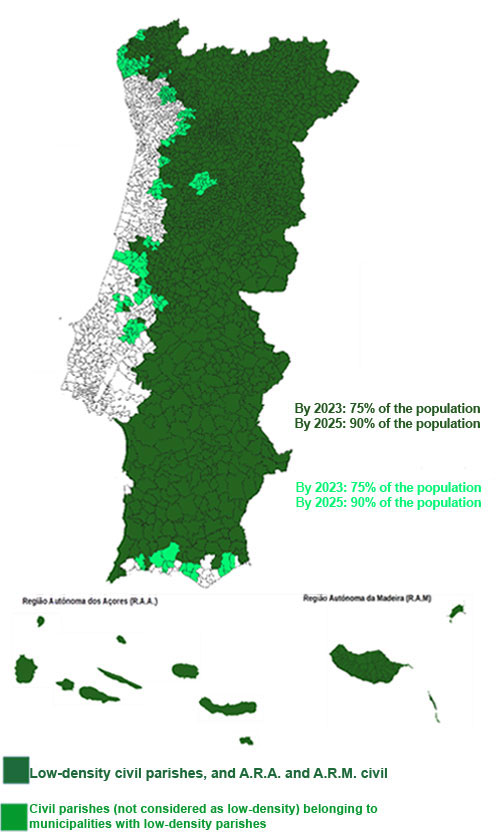Portugal has created the conditions to be one of the first countries in the European Union to cover its entire territory with very high capacity fixed networks, specifically based on the use of optical fibre, which will enable a speed per access of at least 1 Gbps downstream and 150 Mbps upstream, based on a total investment of around EUR 345 million, partly financed by public funds. At the same time, no part of the country will be left behind in terms of mobile network coverage, with a significant improvement in quality.
ANACOM welcomes the fact that Portugal is the first country in the European Union to launch an international public tender for the installation, management, operation and maintenance of very high capacity networks in “white areas”, using European funds, namely the ERDF, within the framework of the new Community rules and criteria applicable to State aid for broadband networks, which could reach EUR 142.6 million.
ANACOM also welcomes the Government’s decision to allocate EUR 29.7 million of the proceeds from the 5G auction to support the national public funds needed to implement this important investment for the development of electronic communications in Portugal, which means that public investment could total EUR 172 million, or around 50% of the total investment.
This has been achieved thanks to the extensive work carried out by ANACOM over the last two years, in close institutional cooperation with the Government and within the framework of its statutory mission of support.
The three public consultations organised by ANACOM were based on innovative georeferencing solutions developed by ANACOM. These solutions were essential in order to comply with European rules allowing the use of European funds in the context of State aid, as they made it possible to accurately identify and visualise the areas where high-capacity networks do not exist.
The geographical survey that led to the identification of the “white areas” included a methodology that made it possible, for the first time, to determine the existence of a house-to-house coverage. As a result, 417 thousand buildings were identified as part of these areas and should be covered by this investment, covering both residential and non-residential buildings (the latter referring to industrial, commercial and agricultural facilities).
Figure 1 – White areas covered by the investment
Source:GEO.ANACOM (https://geo.anacom.pthttps://geo.anacom.pt/publico/home)
All this information is available on the GEO.ANACOMhttps://geo.anacom.pt/publico/home public portal, a geospatial platform that allows its users to access a set of geo-referenced information on the electronic communications and postal services sector, and that is at the forefront of the most modern and emerging technologies for the development of geographic information systems.
ANACOM also provided the best cooperation in the preparation of the relevant specifications and tender programme. Particularly noteworthy are the obligations of transparency and non-discrimination in the wholesale offer, as well as the need to start quickly and to complete the installation of the very high capacity network within three years, guaranteeing a cumulative coverage of buildings of at least 35% at the end of the first year, 75% at the end of the second year and 100% at the end of the third year. A building is considered to be covered if the contractor is able to provide network and wholesale access conditions to a retail operator within four weeks so that the retail operator can provide service to an end user in that building.
ANACOM will be responsible for verifying compliance with the obligations relating to the installation of very high capacity networks.
ANACOM considers that this investment in the fixed network complements the investment made in mobile coverage. According to the commitments made in the 5G auction, by the end of this year, all low-density civil parishes and all civil parishes in the Autonomous Regions of Madeira and the Azores will have improved mobile coverage, which should result in each of these parishes having a mobile broadband service with a speed of 100 Mbps (NOS and Vodafone) and 50 Mbps (MEO), covering at least 75% of the population of the civil parish (by the end of 2025, coverage should be at least 90%).
Figure 2 – Coverage obligations as a result of the 5G auction

Also in the context of the implementation of the 5th generation of mobile networks (5G), ANACOM will continue to carry out supervisory actions to ensure strict compliance with the obligations imposed by the 5G auction.
The development of fixed and mobile networks throughout the country has been given the highest attention and priority in ANACOM’s actions, in fulfilment of its mission and the strategic objectives of its activity plan, with the aim of ensuring access to communications and Internet services for Portuguese citizens who do not have access to these services or who have limited and poor quality access.
ANACOM has done its utmost to guarantee access to communications services for all citizens, correcting existing situations of discrimination, believing that Portugal’s development and social cohesion require the highest priority to be given to the provision of quality communications and the fight against the digital divide, as indispensable conditions for the harmonious development of Portugal, halting and reversing the process of desertification in some of its regions.




